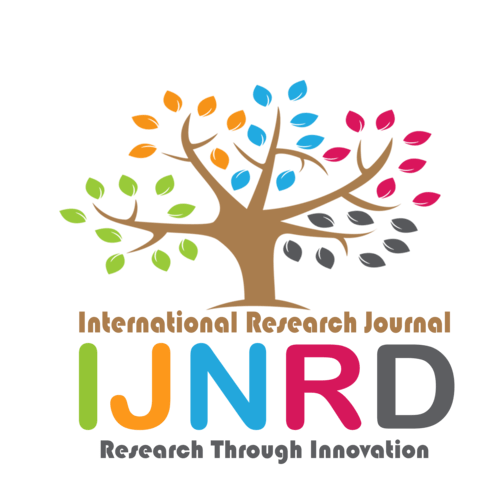|
|||||||||||||||

|
INTERNATIONAL JOURNAL OF NOVEL RESEARCH AND DEVELOPMENT International Peer Reviewed & Refereed Journals, Open Access Journal ISSN Approved Journal No: 2456-4184 | Impact factor: 8.76 | ESTD Year: 2016 Scholarly open access journals, Peer-reviewed, and Refereed Journals, Impact factor 8.76 (Calculate by google scholar and Semantic Scholar | AI-Powered Research Tool) , Multidisciplinary, Monthly, Indexing in all major database & Metadata, Citation Generator, Digital Object Identifier(DOI) |
||||||||||||||
Issue: May 2024
Volume 9 | Issue 5
Review Result and Publication of Paper within : 2-3 days
Click Here For more DetailsFor Authors
Forms / Download
Published Issue Details
Editorial Board
Other IMP Links
Facts & Figure
Impact Factor : 8.76
Issue per Year : 12
Volume Published : 9
Issue Published : 96
Article Submitted :
Article Published :
Total Authors :
Total Reviewer :
Total Countries :
Indexing Partner
Join RMS/Earn 300
Licence
This work is licensed under a Creative Commons Attribution-NonCommercial 4.0 International License







|
Published Paper Details
|
|
| Paper Title: | STUDY ON SELF HEALING CONCRETE BY THE USE OF BACILLUS SUBTILIS BACTERIA |
| Authors Name: | Shivansh Mishra , Pratiksha Maddhessiya , Ranvir Singh , Prince Verma , Shivangi Singh |
| Download E-Certificate: | Download |
| Author Reg. ID: |
IJNRD_195088
|
| Published Paper Id: | IJNRD2305331 |
| Published In: | Volume 8 Issue 5, May-2023 |
| DOI: | |
| Abstract: | Cracks in concrete structures is a universal issue and a very common phenomenon due to relatively low tensile, poor construction, temperature variation, creep, poor design of building etc. Water infiltration into concrete structures can be a significant issue, decreasing their overall durability and making them more susceptible to damage over time. This is because water can seep into the concrete, causing it to deteriorate and leading to corrosion of any steel reinforcement that comes into contact with it. Over time, this can compromise the integrity of the entire structure, creating potential safety hazards and reducing its overall lifespan. By addressing water infiltration through innovative approaches like self-healing and bacterial concrete, we can help to ensure that our infrastructure remains strong and resilient for years to come. Depending upon the cracks of the building, maintenance and treatment is provided. Revolutionizing the field of construction, self-healing concrete represents a ground-breaking solution to one of the most pressing challenges facing the industry: the issue of cracks and deterioration. By leveraging the inherent self-repairing abilities of certain materials, engineers have developed a way to create concrete that can heal itself, preventing further damage and extending the lifespan of structures. This innovative concept holds the promise of creating a more sustainable and resilient built environment, one that can withstand the challenges of our rapidly changing world. This remarkable ability of materials to heal themselves automatically has been incorporated into concrete, allowing it to repair its own cracks and prevent further damage. Bacteria is used as a healing agent as it forms calcium carbonate when it comes in contact with the water which seeps in due to the cracks. Bacteria such as Bacillus subtilis, Bacillus megaterium, B. pasteurii are commonly used in the experiments done previously. Culture of the bacteria demands a particular temperature and a particular time period. In recent studies, researchers have discovered that integrating bacteria into concrete can result in remarkable improvements to its strength, water absorption, and resistance to environmental hazards like freeze and thaw cycles. In fact, bacterial concrete has been shown to outperform conventional concrete in terms of permeability and durability. By harnessing the power of nature in this way, we can create stronger, more resilient structures that are better equipped to withstand the challenges of our changing world. |
| Keywords: | Concrete, Cracks, Bacteria, Self-healing, Strength, Bacillus subtilis |
| Cite Article: | "STUDY ON SELF HEALING CONCRETE BY THE USE OF BACILLUS SUBTILIS BACTERIA ", International Journal of Novel Research and Development (www.ijnrd.org), ISSN:2456-4184, Vol.8, Issue 5, page no.d224-d228, May-2023, Available :http://www.ijnrd.org/papers/IJNRD2305331.pdf |
| Downloads: | 000118753 |
| ISSN: |
2456-4184 | IMPACT FACTOR: 8.76 Calculated By Google Scholar| ESTD YEAR: 2016 An International Scholarly Open Access Journal, Peer-Reviewed, Refereed Journal Impact Factor 8.76 Calculate by Google Scholar and Semantic Scholar | AI-Powered Research Tool, Multidisciplinary, Monthly, Multilanguage Journal Indexing in All Major Database & Metadata, Citation Generator |
| Publication Details: |
Published Paper ID:IJNRD2305331 Registration ID: 195088 Published In: Volume 8 Issue 5, May-2023 DOI (Digital Object Identifier): Page No: d224-d228 Country: Ayodhya, Uttar Pradesh, India Research Area: Civil Engineering Publisher : IJ Publication Published Paper URL : https://www.ijnrd.org/viewpaperforall?paper=IJNRD2305331 Published Paper PDF: https://www.ijnrd.org/papers/IJNRD2305331 |
| Share Article: | |
|
Click Here to Download This Article |
|
| Article Preview | |
|
|
|
Major Indexing from www.ijnrd.org
| Semantic Scholar | Microsaoft Academic | ORCID | Zenodo |
| Google Scholar | ResearcherID Thomson Reuters | Mendeley : reference manager | Academia.edu |
| arXiv.org : cornell university library | Research Gate | CiteSeerX | PUBLON |
| DRJI | SSRN | Scribd | DocStoc |
ISSN Details
 |
 |
ISSN: 2456-4184
Impact Factor: 8.76 and ISSN APPROVED
Journal Starting Year (ESTD) : 2016
DOI (A digital object identifier)
Conference
Open Access License Policy
Important Details
Social Media
| Copyright © 2024 - All Rights Reserved - IJNRD |












Facebook Twitter Instagram LinkedIn